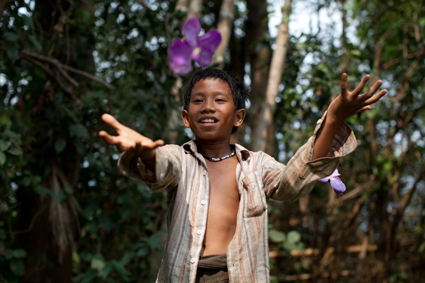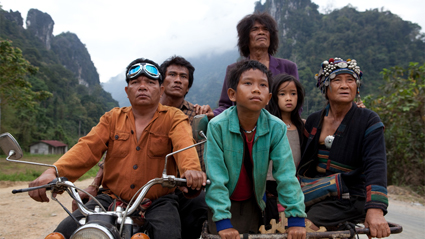A troubled love letter to Laos
Katerina Sakkas: Kim Mordaunt, The Rocket

The Rocket
In 2007 director Kim Mordaunt and producer Sylvia Wilczynski released their documentary Bomb Harvest (see Dan Edwards’ review, RT80, p31). Shot in Laos, it followed Australian bomb disposal specialist Laith Stevens as he trained a local team in the business of tackling the devastating legacy of the United States’ indiscriminate, covert bombing of the country during the Vietnam War.
During the making of this documentary a sub-narrative emerged: that of the village children who make a dangerous living scavenging for bomb scrap metal to sell. These children, Mordaunt explains at a post-screening Q and A, would go on to inspire his and Wilczynski’s subsequent dramatic feature, The Rocket.
Lyrical and exquisitely observed, The Rocket is a story of cheek and determination in the face of dispossession and tragedy. Its resourceful yet accident-prone child hero, Ahlo (Sitthiphon Disamoe), forced with his family to move from their home in the mountains of Northern Laos to make way for a new dam, seeks to disprove the prevailing superstition that he is the bearer of bad luck by planning to build the largest and most explosive entry at an upcoming rocket festival. The narrative theme of the child embarking on what appears an overly ambitious quest to put things right is reassuring in its familiarity, yet Mordaunt employs it here to navigate a social and environmental situation of staggering complexity.

The Rocket
There are similarities between The Rocket and another Australian film released this year, Catriona McKenzie’s Satellite Boy. Both begin with eviction, charting a child’s journey through a landscape heavy with a sense of the numinous. However, while the landscape in Satellite Boy shelters the young protagonist, it is rife with danger in The Rocket—ready to maim or kill at any moment. Andrew Commis’ cinematography is instrumental in marrying the intimate playfulness of the child’s experience with the mysticism and peril of the landscape. Through vertiginous scenes—such as one where Ahlo is suspended on a rope swing above a mountainous drop, shrieking with laughter—and others which play with scale, pitting ant-like humans against majestic surroundings, Commis offers a window onto the sublime.
Commis’ vistas might stun the eye but do not dwarf the performances in this character-driven work. As they veer between joyful playfulness, stubbornness, anger and sadness, Sitthiphon Disamoe and his fellow child lead Loungnam Kaosainam (playing Ahlo’s friend Kia) convey extraordinary depth. The adult cast, most of whom have backgrounds in comedy and slapstick, were well-equipped—after an accelerated method acting course from Mordaunt—to walk the line between comedy and pathos the film required.
The world of The Rocket is one of great richness and complexity with an edge of the surreal, as embodied in the figure of Kia’s purple besuited, James Brown-impersonating alcoholic uncle (Thep Phongam). While Uncle Purple’s louche emergence strikes a humorously incongruous note, it has a darker significance. Purple is one of the CIA-backed Hmong who fought against the Lao during the country’s civil war (hence the adoption of American pop cultural references). There’s more than one reason he’s an outcast. The Rocket’s poetry is always underscored by disturbing truths.
In the breadth of its humanist vision, the film comes across as a somewhat troubled love letter to Laos from two Australian filmmakers who have lived and worked in the region (based mainly in Vietnam) and know it, perhaps, as well as any non-local can. While ‘outsiders’ telling another country’s story should always be regarded with caution, it’s surely a welcome development for Australian filmmakers to offer insight into the demanding circumstances of one of Australia’s near neighbours.
The Rocket, writer-director Kim Mordaunt, cinematography Andrew Commis, editor Nick Meyers, composer Caitlin Yeo, producer Sylvia Wilczynski; Curious Films, released 29 Aug
RealTime issue #117 Oct-Nov 2013 pg. 16






